Ir a la versión en español
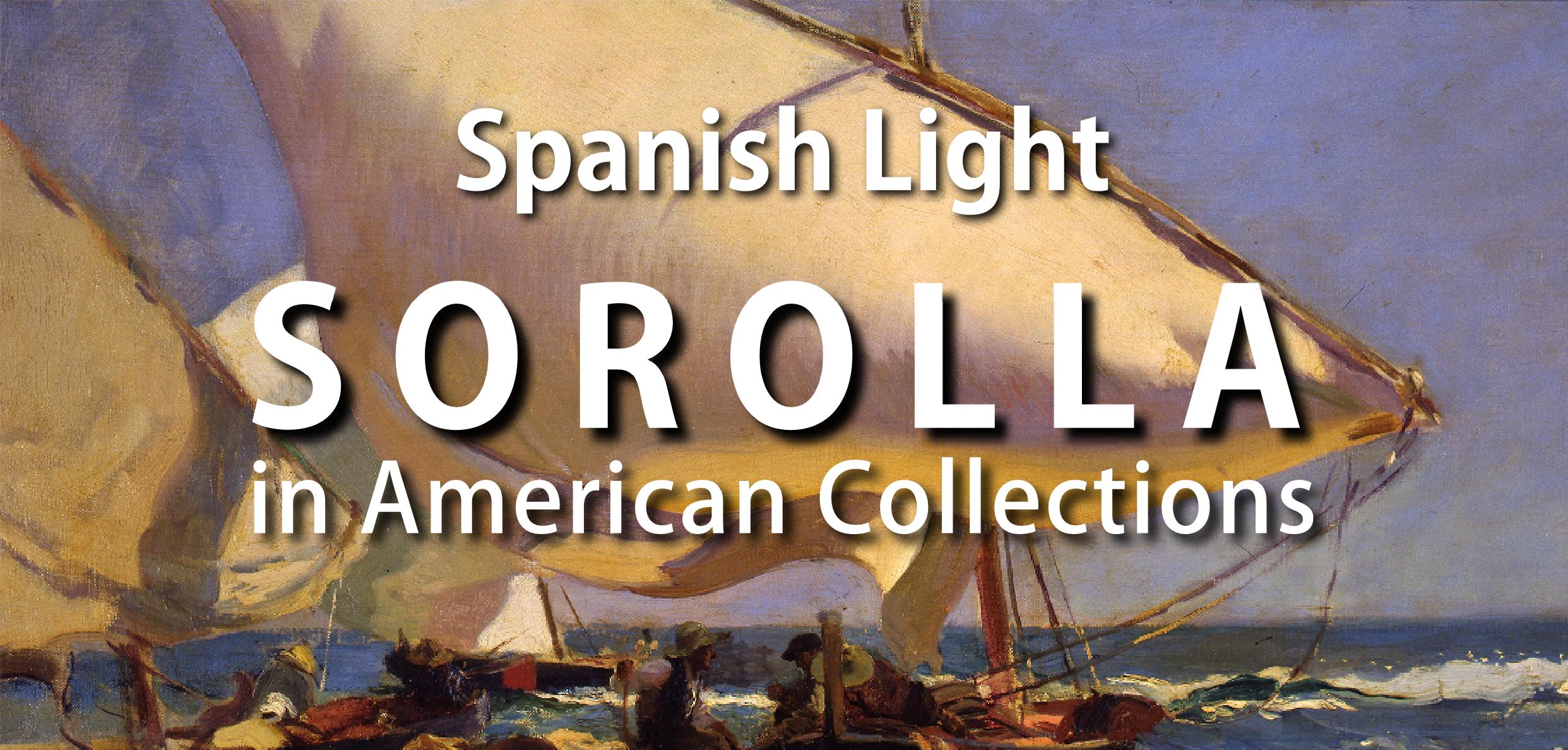 Meadows Museum to present works by Joaquín Sorolla y Bastida (1863-1923)
Meadows Museum to present works by Joaquín Sorolla y Bastida (1863-1923)
as part of “Year of Sorolla” celebrations in Spain and America.
From September 17, 2023 through January 7, 2024
The exhibition presents a number of Sorolla’s
selected masterpieces depicting his favorite subjects
found in the American collections
HIGHLIGHTS
SOROLLA: THE SEA AND ITS PEOPLE
Sorolla’s luminous palette is so dazzling that it can distract the observer
from the magnitude of another of the great achievements of his painting,
where he manages to capture masterfully, like a snapshot, a moment
in the life of his characters and the environment that surrounds them.
Sorolla’s works are an immersive painting in movement.
Beach of Valencia, 1908
Joaquín Sorolla y Bastida (Spanish, 1863–1923),
Oil on canvas, 26 x 37 ¾ in. (66 x 96 cm). Cristina H. Noble.
Photo: Personal Archive, Blanca Pons-Sorolla, Madrid
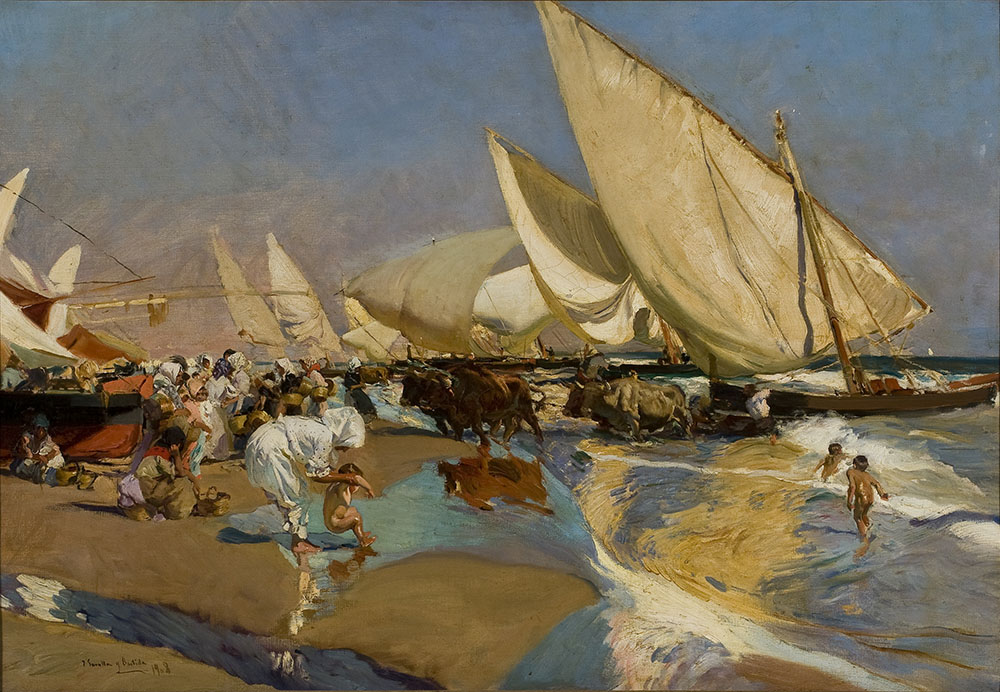 Sorolla and the poetry of sails. There is a fascination of Sorolla for the sails of the boats that he manages to turn into a visual poetry where we perceive the sea breeze and the sails that dance to its rhythm. In this work, Sorolla displays all the charms of the sails, when he portrays a group of boats the landscape becomes a ballet where the prima donna is in the foreground admiring herself in the water.
Sorolla and the poetry of sails. There is a fascination of Sorolla for the sails of the boats that he manages to turn into a visual poetry where we perceive the sea breeze and the sails that dance to its rhythm. In this work, Sorolla displays all the charms of the sails, when he portrays a group of boats the landscape becomes a ballet where the prima donna is in the foreground admiring herself in the water.
Detail of Beach of Valencia, 1908
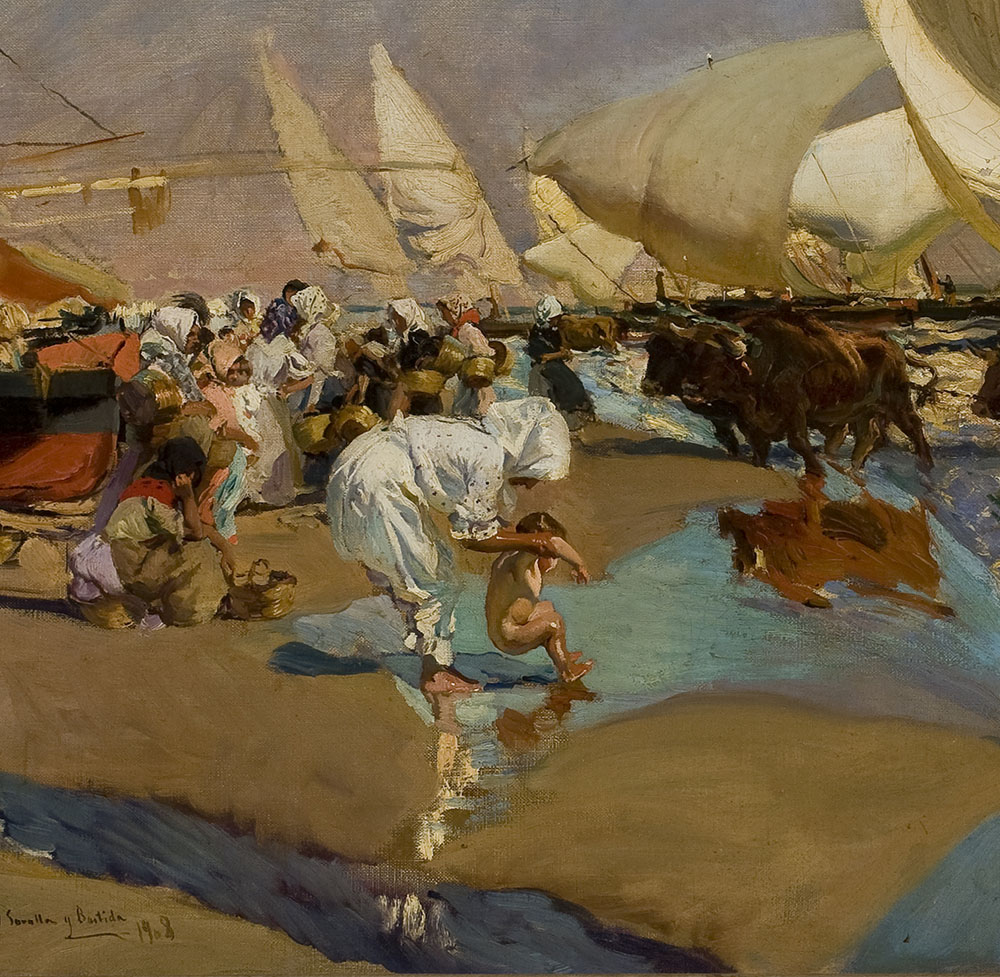
Detail of Beach of Valencia, 1908

Beach of Valencia, 1908
Joaquín Sorolla y Bastida (Spanish, 1863–1923),
Oil on canvas, 26 3/8 x 38 1/4 in. (67 x 97.2 cm). Cristina H. Noble.
Photo: Personal Archive, Blanca Pons-Sorolla, Madrid
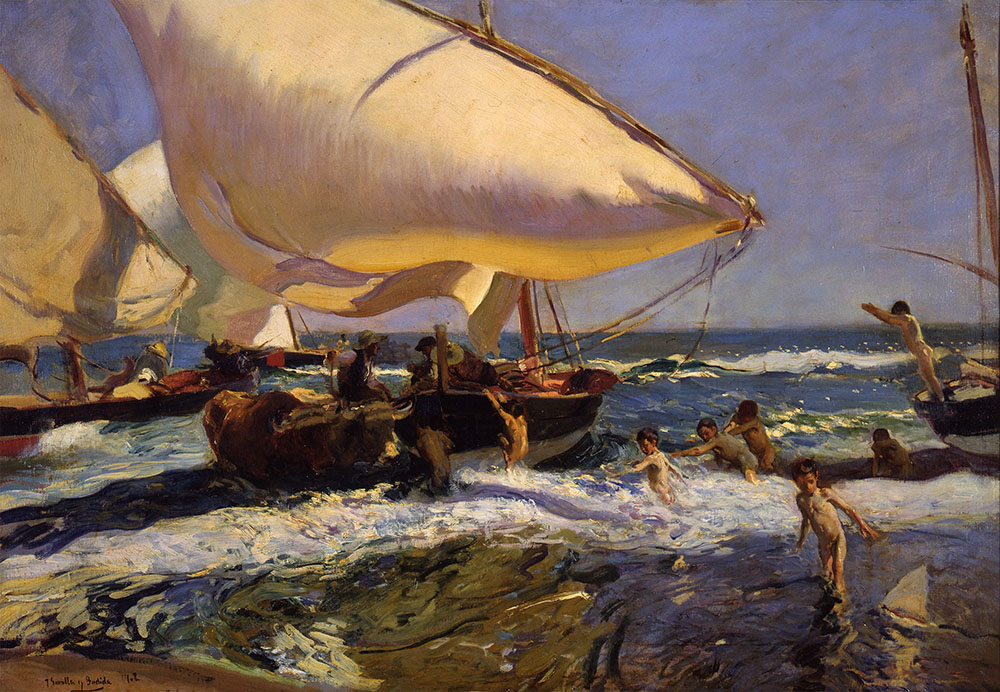 This work contains another of his masterful compositions
This work contains another of his masterful compositions
where Sorolla shows his extraordinary mastery of the character
of the children who are another of his great pictorial subjects.
Detail of Beach of Valencia, 1908
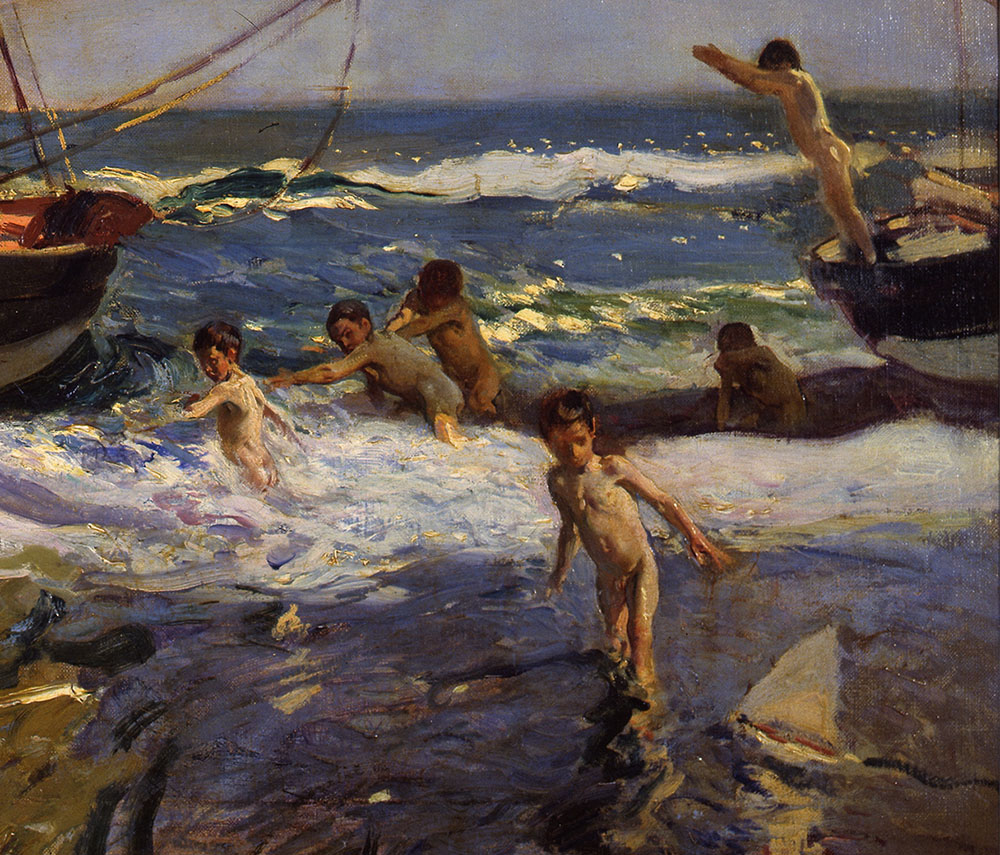
The White Boat, 1905
Joaquín Sorolla y Bastida (Spanish, 1863–1923),
Oil on canvas. 21 1/8 x 59 in. (105 x 150 cm). Cristina H. Noble.
Photo: Personal Archive, Blanca Pons-Sorolla, Madrid
In many of his works, in a close view of the painting,
the weave of the canvas is perceived, demonstrating his extreme skill
in painting with a single accurate and vigorous brushstroke.
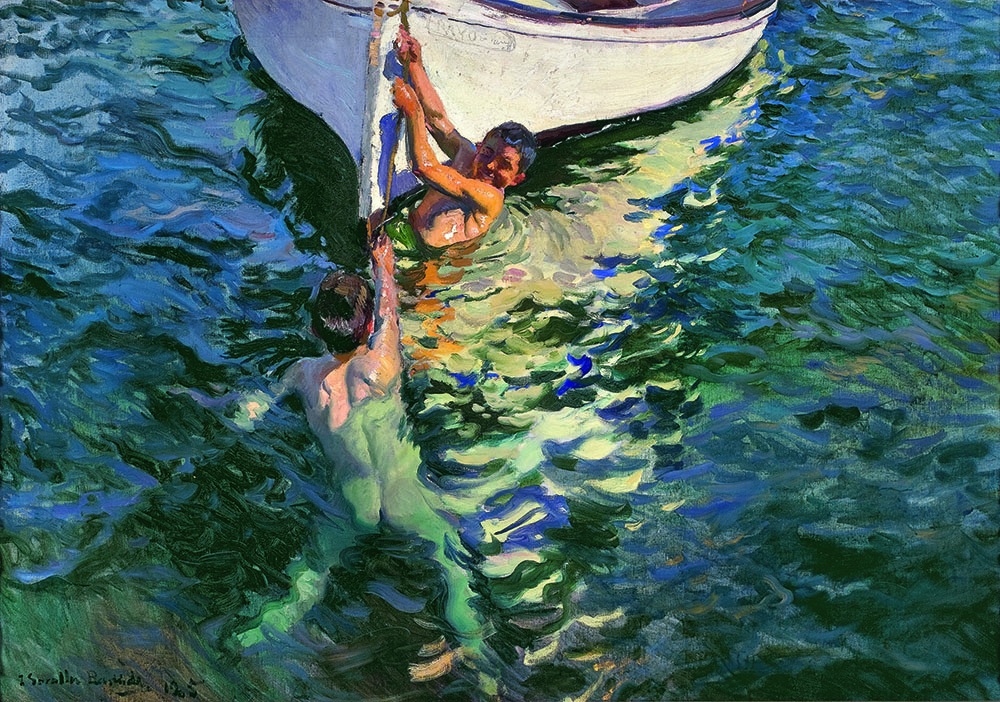
Detail of The White Boat, 1905
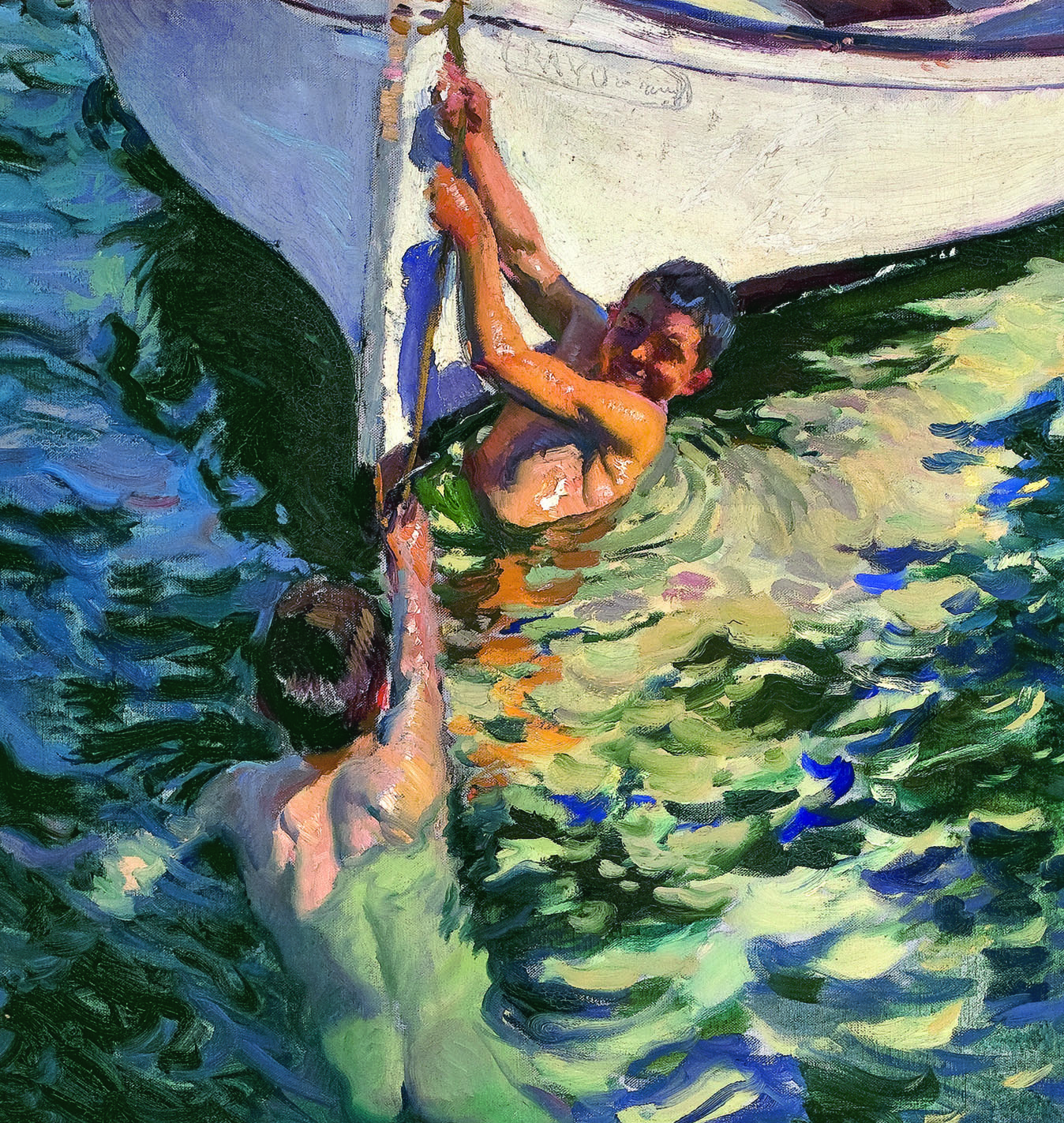
Children in the Sea, Valencia Beach, 1908
Joaquín Sorolla y Bastida (Spanish, 1863–1923),
Oil on canvas, 31 7/8 x 41 ¾ in. (81 x 106 cm). Private Collection, Europe.
Photo: Personal Archive, Blanca Pons-Sorolla, Madrid
The sensation of wet bodies acquire an unsurpassed realism
in Sorolla’s painting. Another demonstration of his masterful technique.
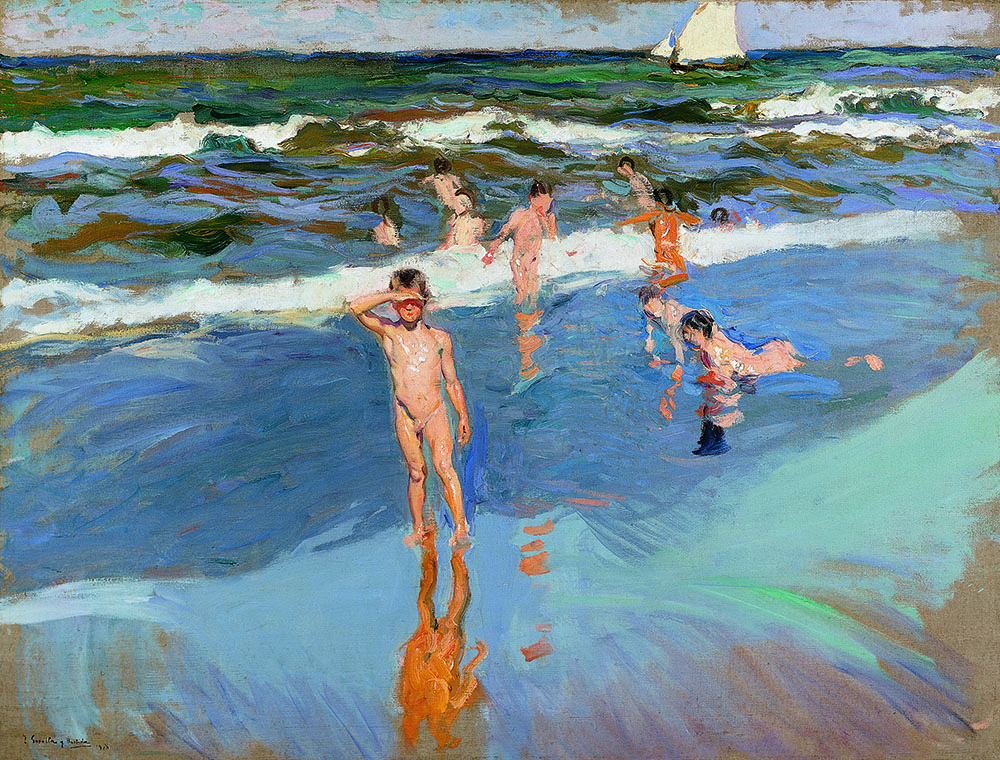
Detail of Children in the Sea, Valencia Beach, 1908

Scene of the Port of Valencia, 1904
Joaquín Sorolla y Bastida (Spanish, 1863–1923)
Oil on canvas, 18 1/2 x 29 in. (47.2 x 73.5 cm). Collection of Debbie Turner.
Photo: Personal Archive, Blanca Pons-Sorolla, Madrid
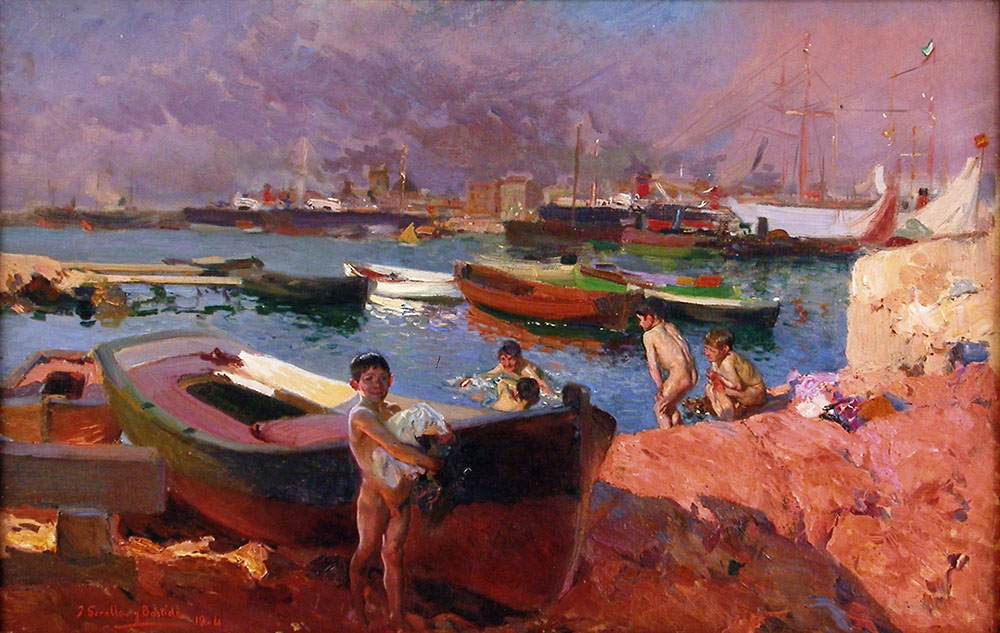
Detail of Scene of the Port of Valencia, 1904
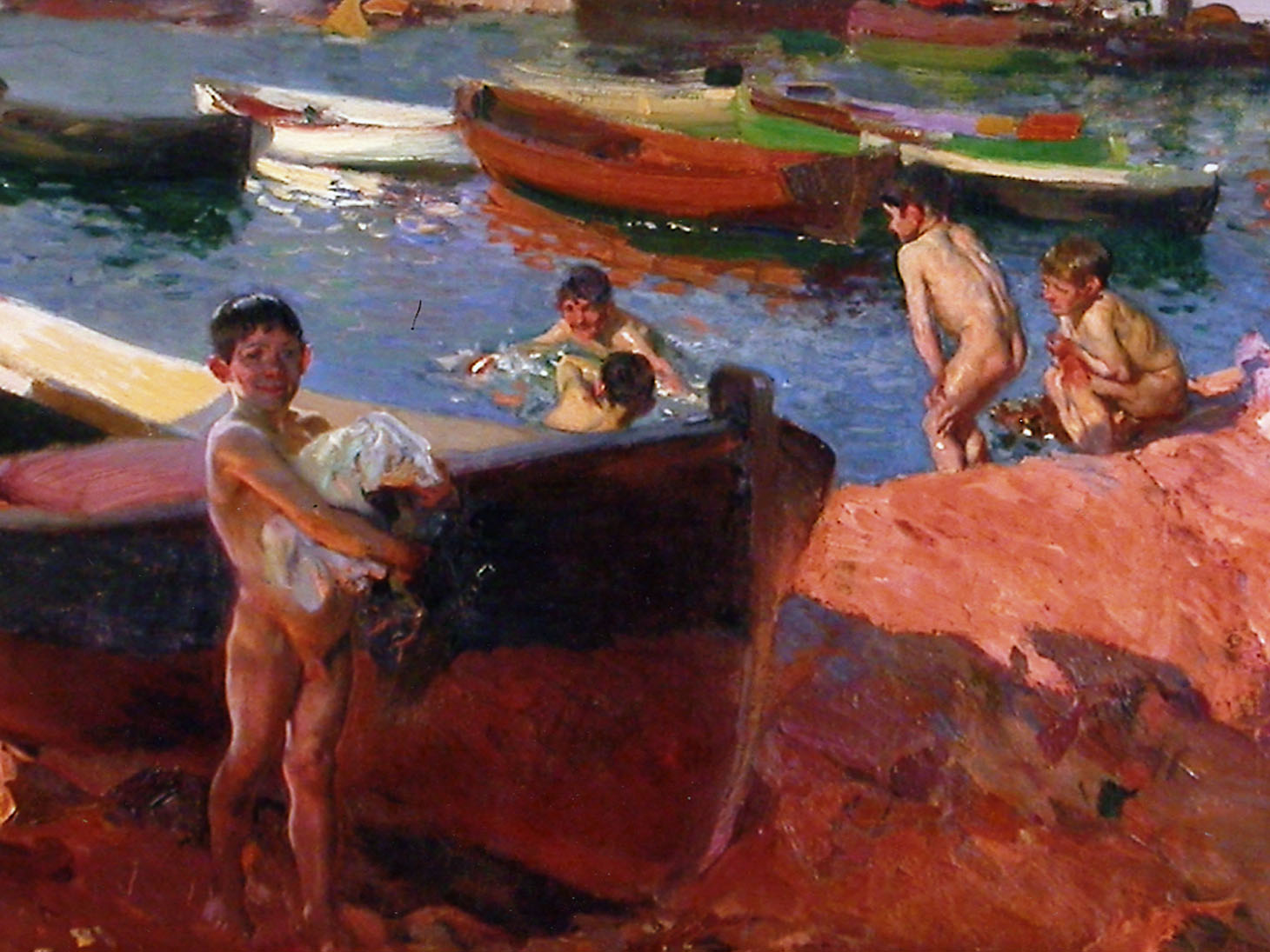
Children Bathing among the Rocks, Jávea, 1905
Joaquín Sorolla y Bastida (Spanish, 1863–1923)
Oil on canvas, 13 x 24 ¾ in. (33 x 62.8 cm). Private Collection, Europe.
Photo: Personal Archive, Blanca Pons-Sorolla, Madrid
Another of his elaborate compositions for a series of paintings
of bathers among the rocks.
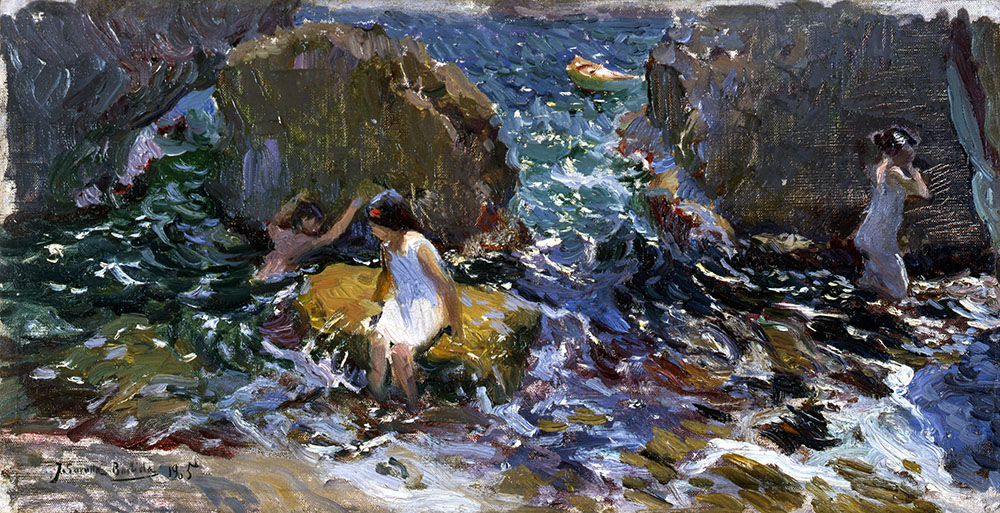
Children on the Beach: Study for “Summer”, 1904
Joaquín Sorolla y Bastida (Spanish, 1863–1923)
Oil on canvas, 29 3/4 x 41 1/2 in. (75.5 x 105.5 cm).
Guggenheim Partners Art Holdings, LLC.
Photo: Personal Archive, Blanca Pons-Sorolla, Madrid
One of Sorolla’s most tender works in which he presents a scene
where filial love can be perceived.
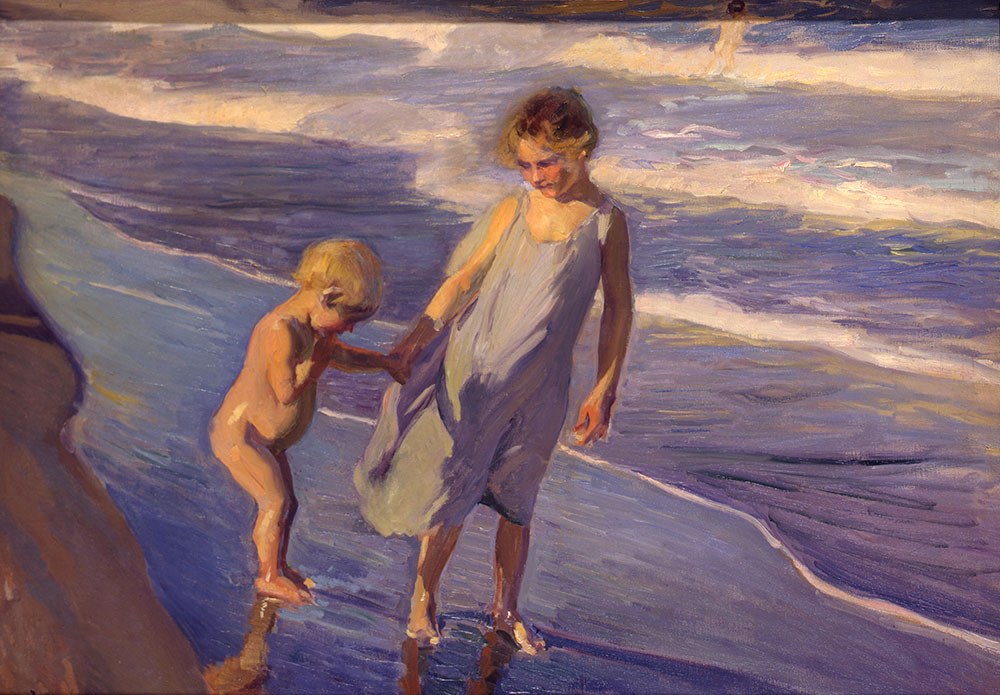
Detail of Children on the Beach: Study for “Summer”, 1904
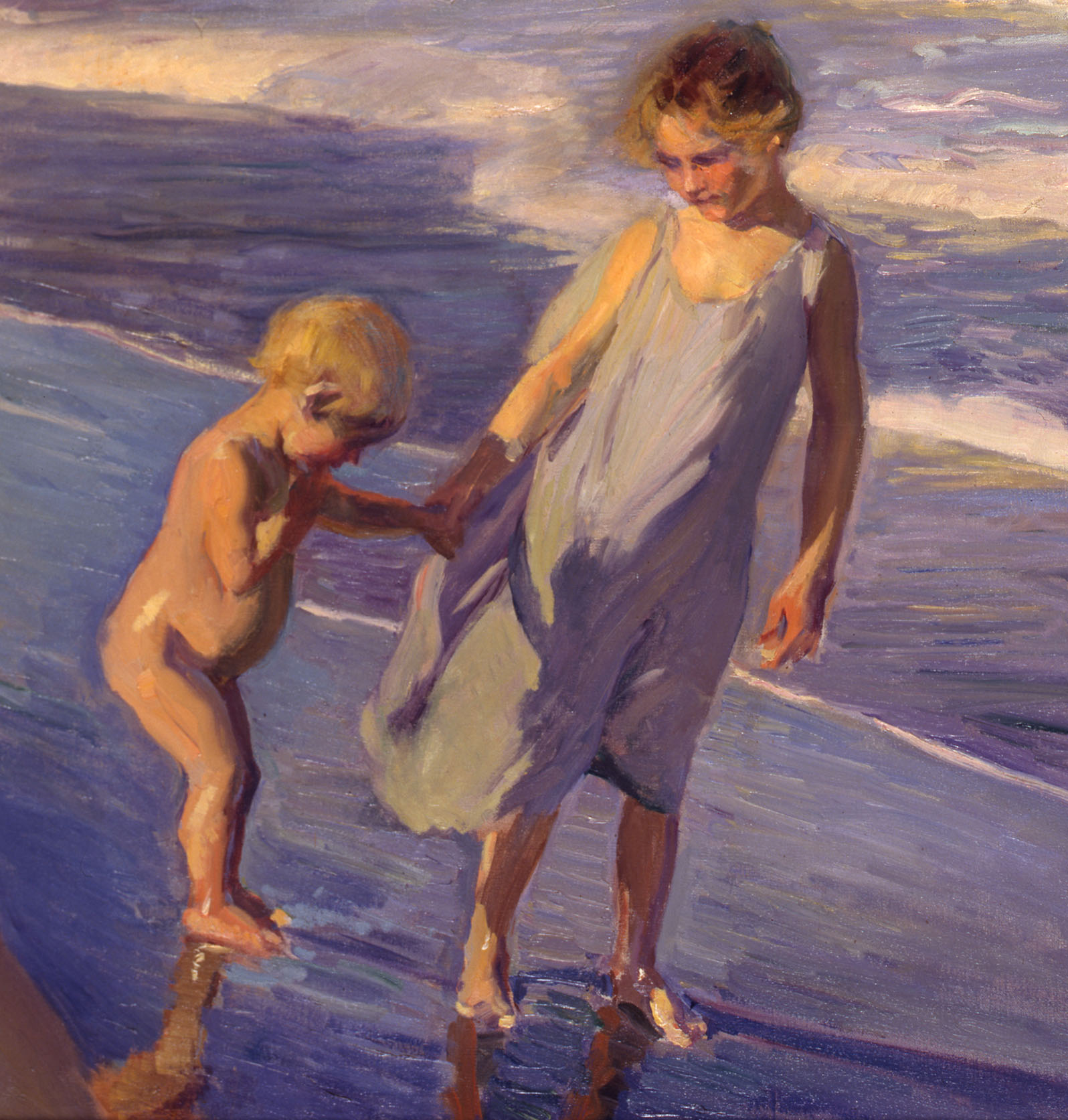
Beach of Biarritz, 1906
Joaquín Sorolla y Bastida (Spanish, 1863–1923)
Oil on wood panel, 8 7/8 x 7 1/8 in. (18 x 22.5 cm).
Emi Knight, Maximilian Knight, and W. Wilder Knight II. Photo: Joerg Lohse
This seemingly minor work is one of the masterpieces in the exhibition.
Sorolla chooses an unusual point of view to show the liveliness of the beach
and the activity of each character can be guessed, despite being suggested
with very elementary brushstrokes. Sorolla’s sketch were highly appreciated
and a resounding sales success.
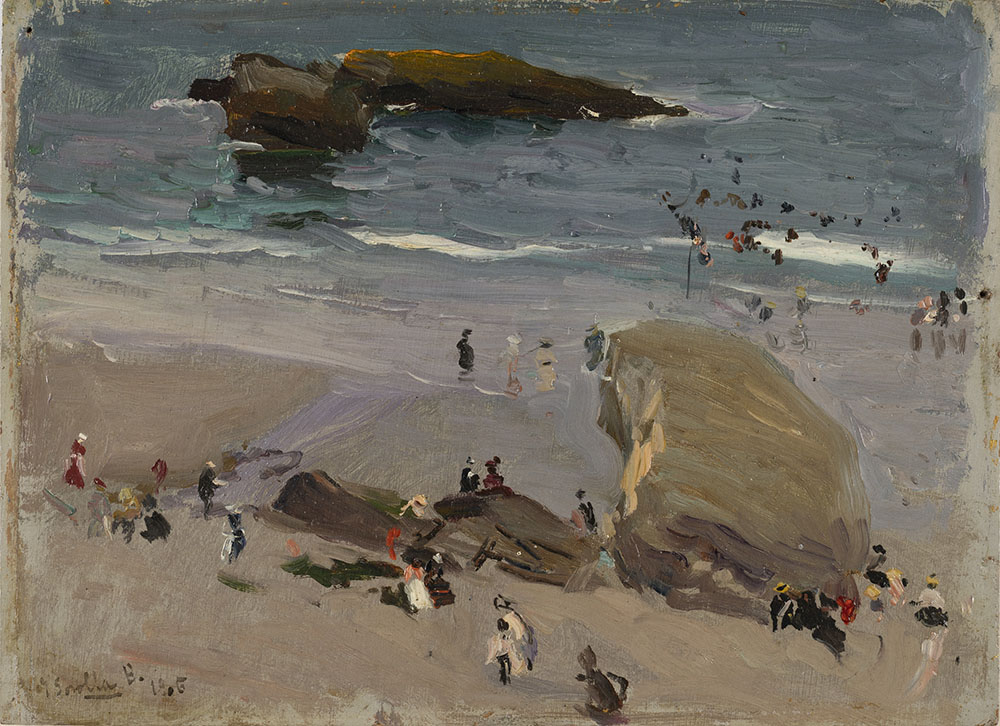
Return of the Boats, Valencia, 1907
Joaquín Sorolla y Bastida (Spanish, 1863–1923)
Oil on canvas, 36 1/8 x 44 ¼ in. (91.8 x 112.5 cm). Collection of Debbie Turner.
Photo: Personal Archive, Blanca Pons-Sorolla, Madrid
Returning from fishing. The oxen pull the boats out of the water
to leave them stranded on the beach.
Fishermen, animals and boats will rest until tomorrow.
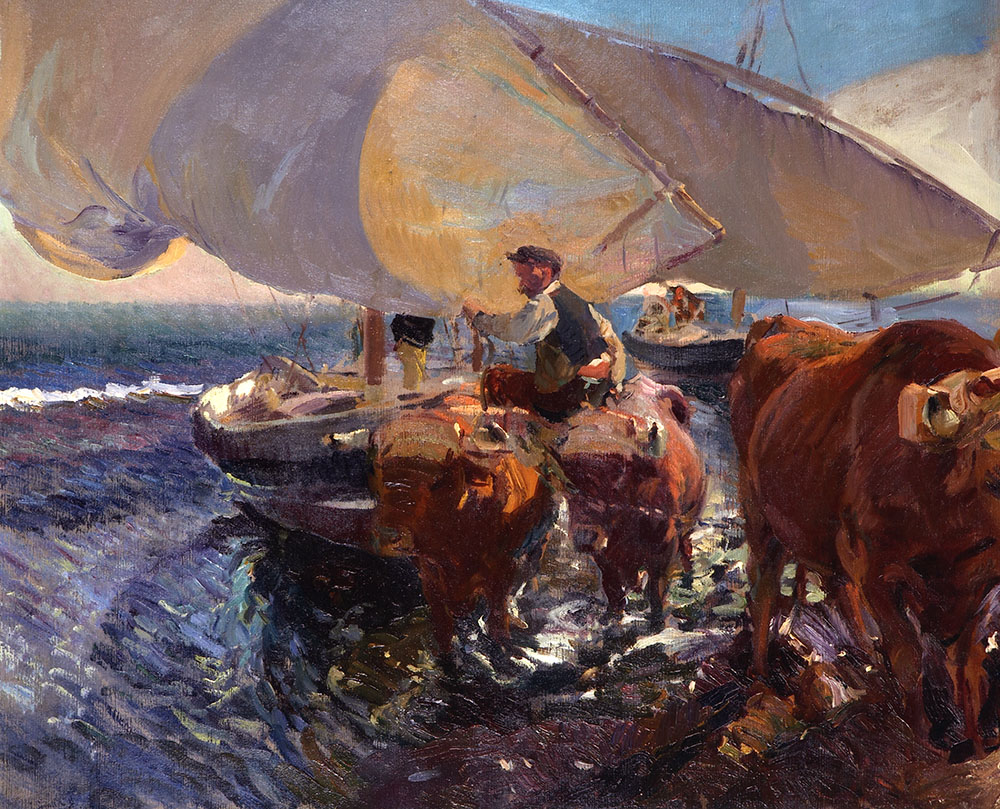
Beach of Valencia (Boats) 1908
Joaquín Sorolla y Bastida (Spanish, 1863–1923)
Oil on canvas, 18 7/8 x 23 1/4 in. (48 x 59 cm). Collection of Debbie Turner.
Photo: Personal Archive, Blanca Pons-Sorolla, Madrid
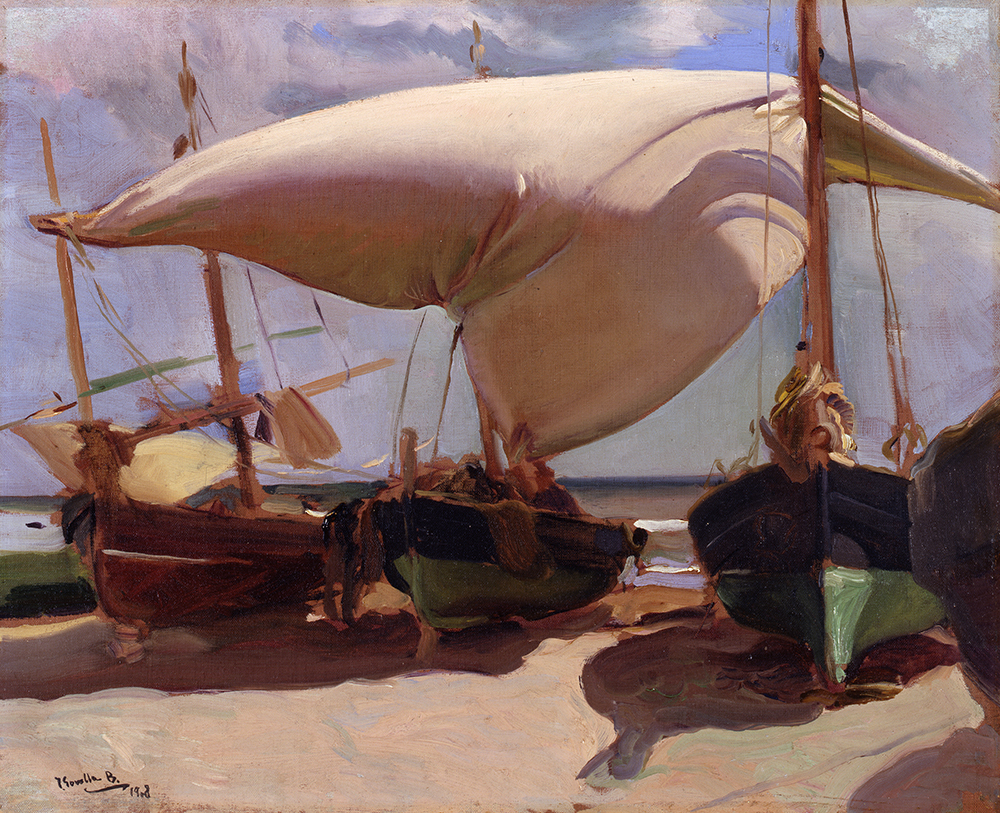
Beach of Valencia, 1904
Joaquín Sorolla y Bastida (Spanish, 1863–1923)
Oil on canvas, 24 1/2 x 26 in. (62 x 66 cm). Karen W. Davidson.
Photo: Personal Archive, Blanca Pons-Sorolla, Madrid
An unusual subject in Sorolla’s painting.
A raging sea serves as a frame for a solitary stroller immersed in his thoughts.

SOROLLA: HIS APPROACHES TO PORTRAITS
The exhibition exhibits portraits that are a representation
of the different registers in which Sorolla could paint a character.
1897, Portrait of the Daughters of Rafael Errázuriz
Joaquín Sorolla y Bastida (Spanish, 1863–1923)
Oil on canvas, 89 1/4 x 54 ¾ in. (226.7 x 139.1 cm). Nancy and Ira Koger Trust, Florida.
Courtesy of Mark Murray Fine Paintings, New York.
Photo: Courtesy of Mark Murray Fine Paintings, New York
In this work Sorolla makes another of his homages to Diego Velázquez
by discreetly introducing his own portrait in the mirror.
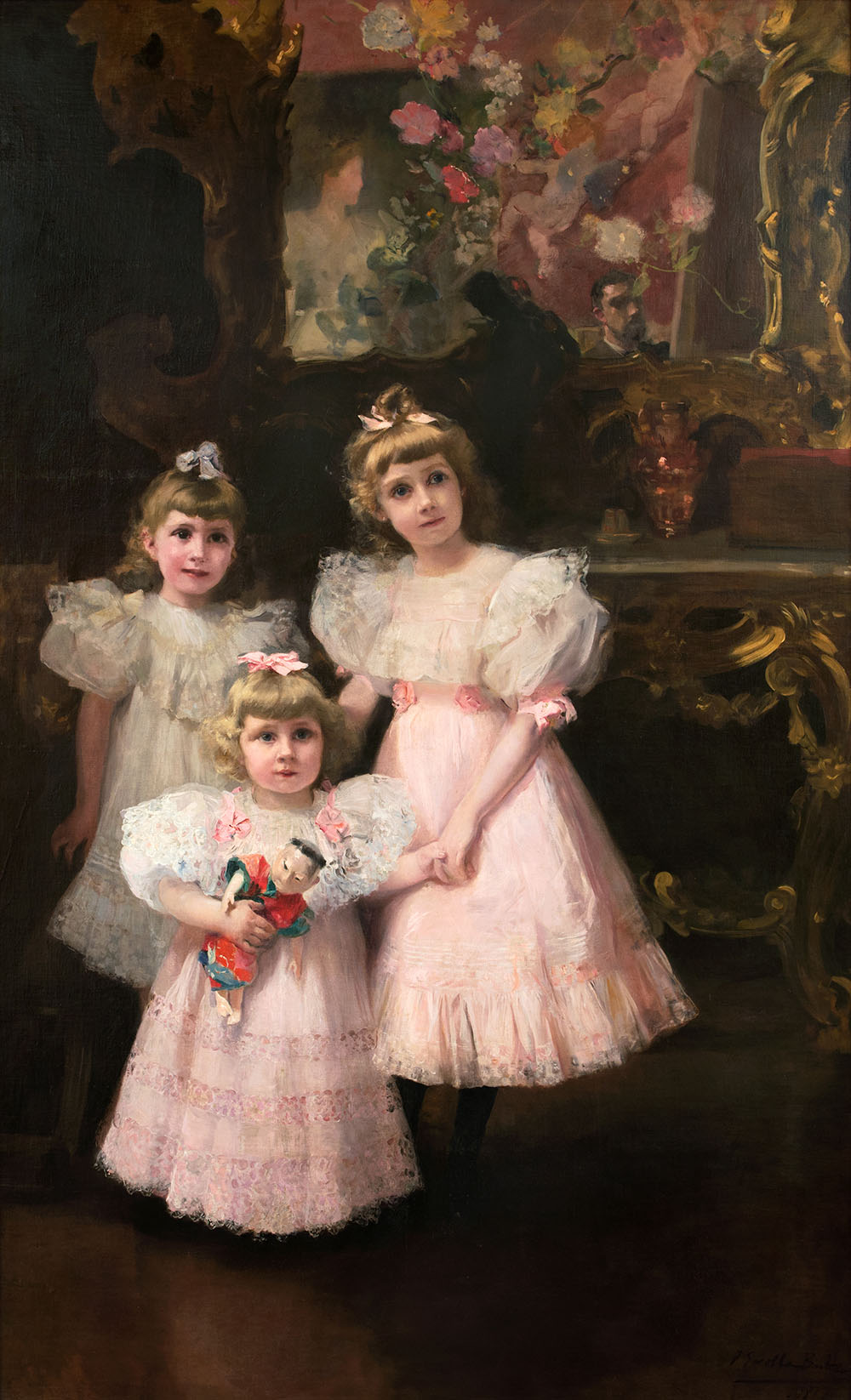
1903, King Alfonso XIII, Study for the Painting “The Regency”
Joaquín Sorolla y Bastida (Spanish
1863–1923) Oil on canvas, 18 7/8 x 32 ¼ in. (48 x 82 cm)
Cristina H. Noble. Photo: Juantxo Egaña
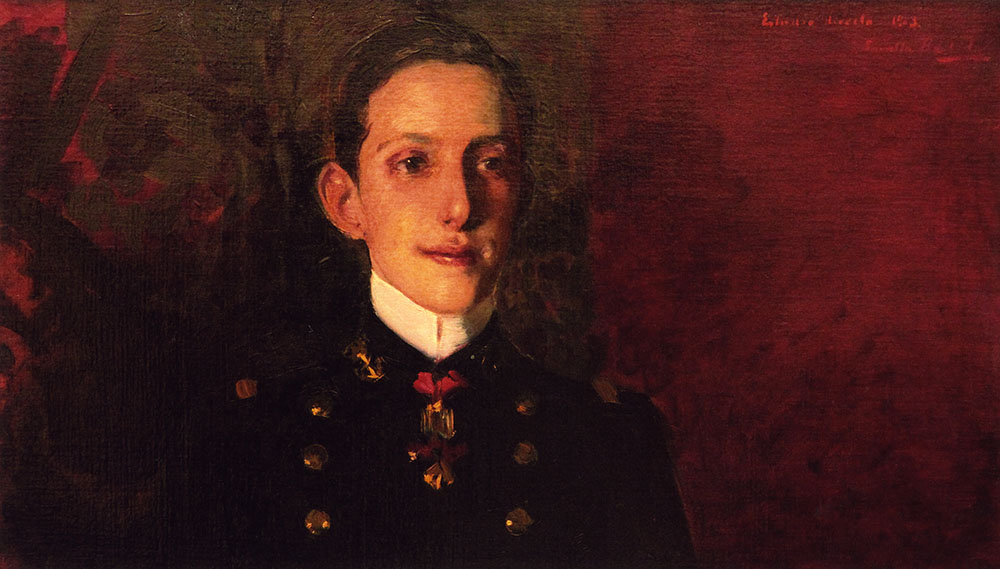
1903, Elenita Dressed as a Menina
Joaquín Sorolla y Bastida (Spanish, 1863–1923)
Oil on canvas, 41 1/8 x 22 in. (107 x 56 cm). Private Collection, Europe.
Photo: Personal Archive, Blanca Pons-Sorolla, Madrid
This is a very important painting because it initiates a decided evolution of his style. The extreme energy, speed and audacity with which this painting is executed, announces the intensity of the brushstrokes in his future works. Only two other artists in history have dared this energetic spontaneity of execution: the Flemish artist Frans Hals (1582-1666) and the Italian Giovanni Boldini (1842-1931)
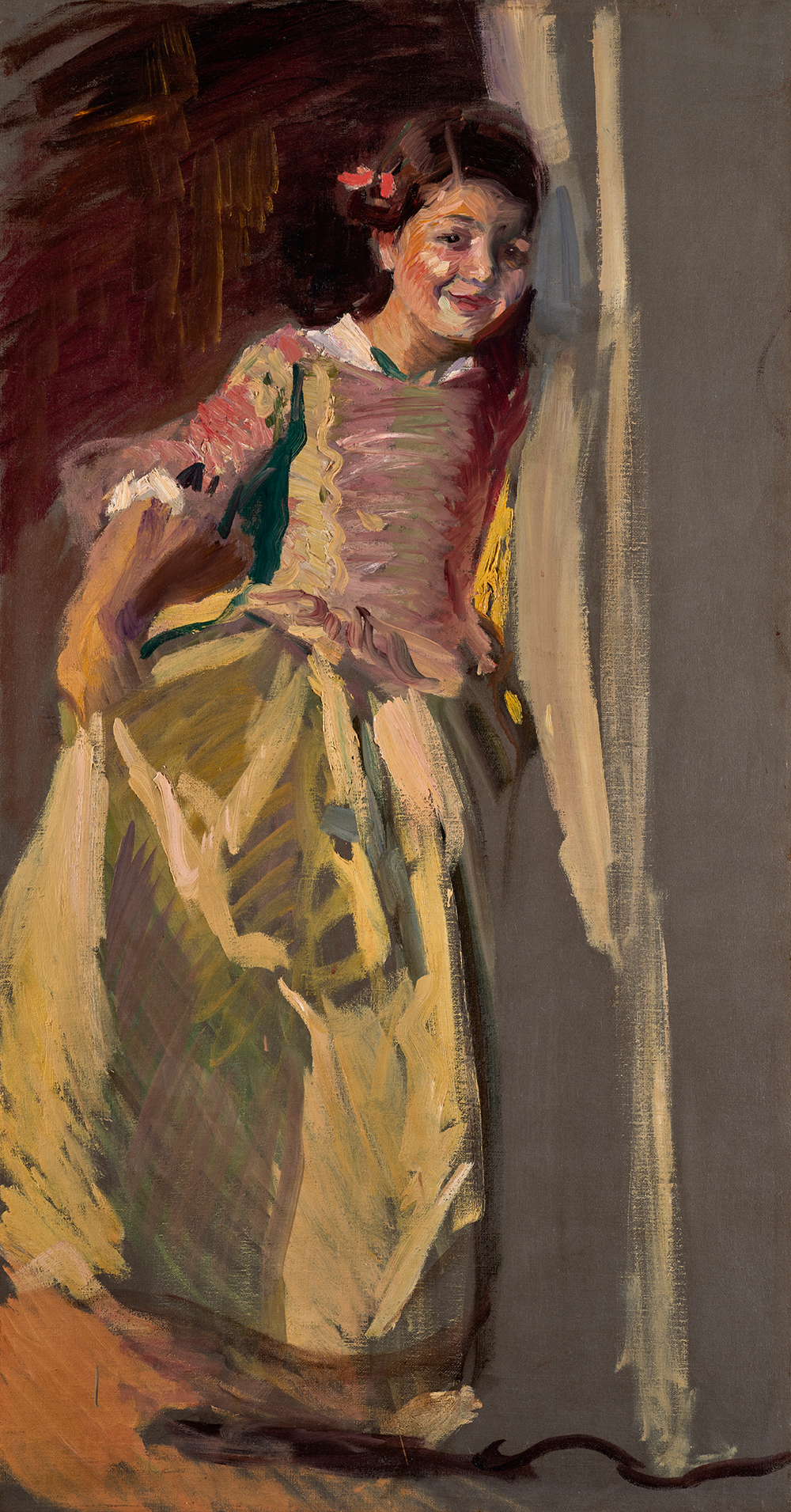
1909, Portrait of Esperanza Conill de Zanetti
Joaquín Sorolla y Bastida (Spanish, 1863–1923)
Oil on canvas, 61 1/4 x 48 7/8 in. (155.5 x 111.5 cm)
Jaime L. Ponce de Leon. Photo: Leon Gallery
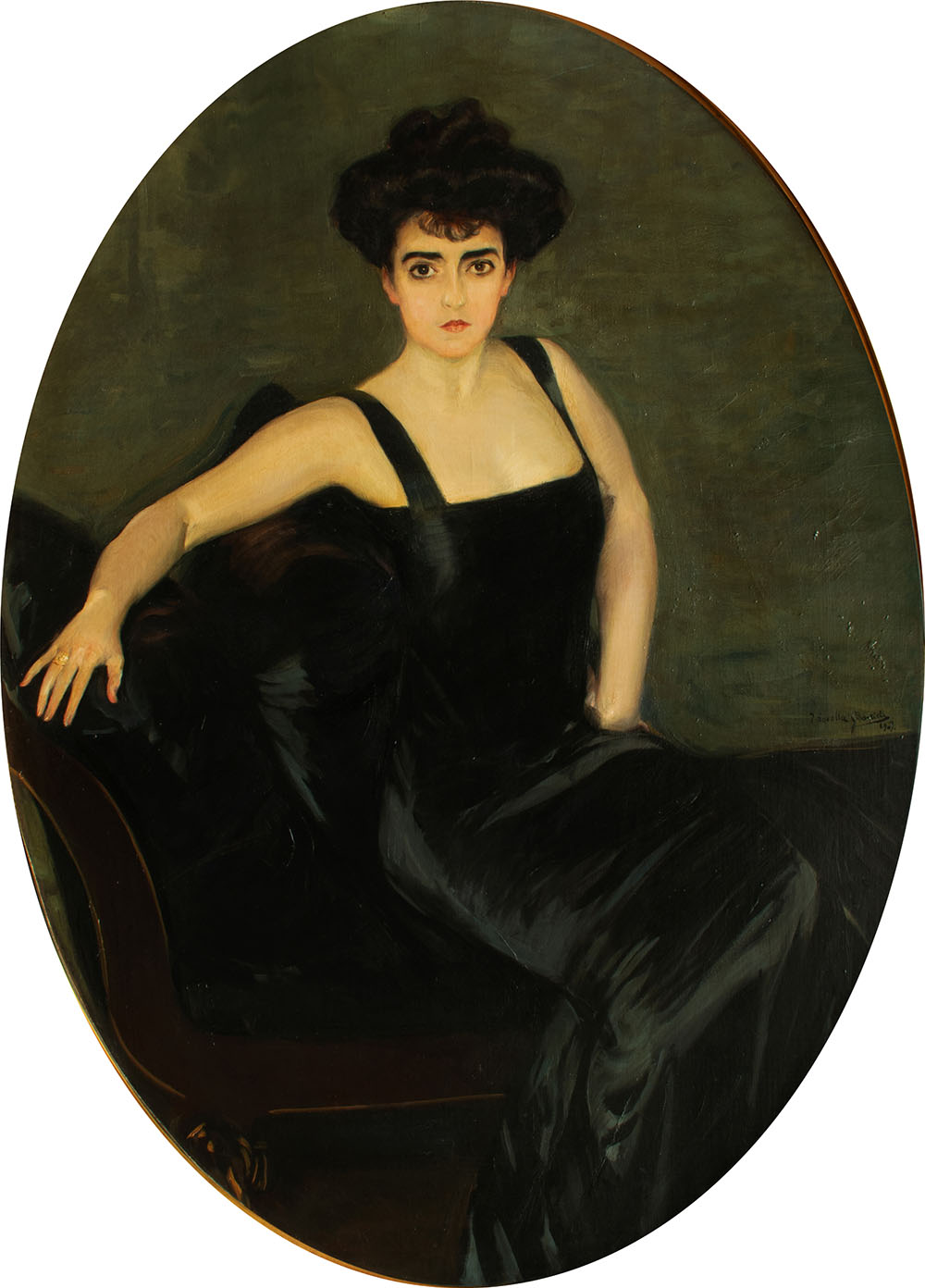
1910, Juan Ángel, Zarauz
Joaquín Sorolla y Bastida (Spanish, 1863–1923)
Oil on canvas, 21 7/8 x 33 ½ in. (55 x 85 cm).
Cristina H. Noble. Photo: Enrci Arimany
This work shows Sorolla’s extreme sensitivity to penetrate the personality of the portrayed. The austerity of the palette and few details reflect the dour spirit of the men of the region.
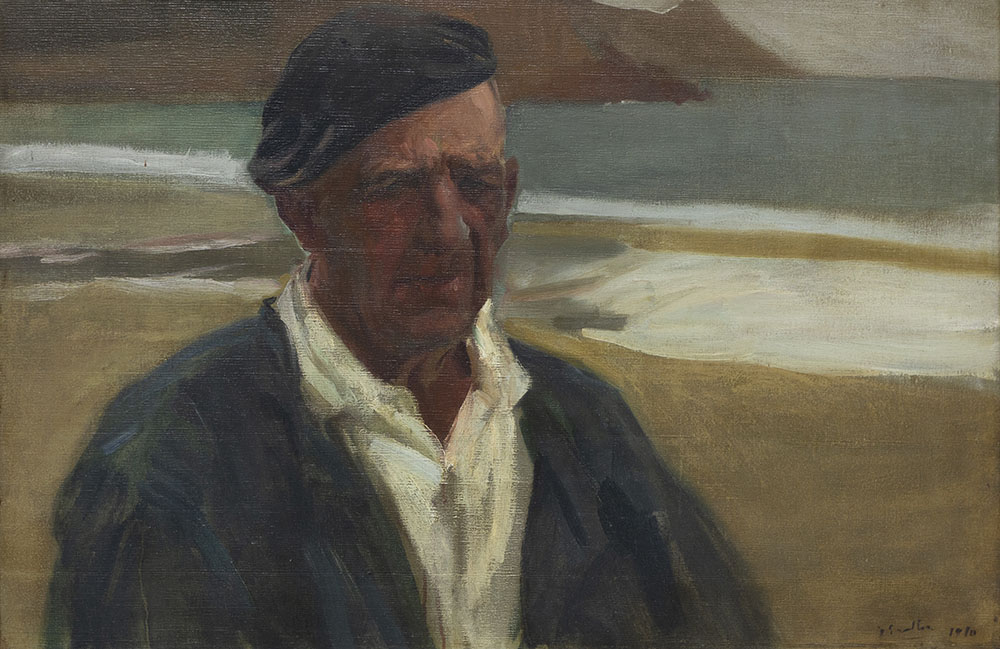
SOROLLA: HIS VISION OF LANDSCAPE
1904, Oleanders Path
Joaquín Sorolla y Bastida (Spanish, 1863–1923)
Oil on canvas, 24 ½ x 30 in. (62 x 76 cm). Private Collection.
Photo: Personal Archive, Blanca Pons-Sorolla, Madrid
Sorolla met these flowers making one of his landscapes
and fell in love with them to the point of cultivating them
in the garden of his residence in Madrid.

c.1918, Detail of the Garden of the Sorolla House
Joaquín Sorolla y Bastida (Spanish, 1863–1923), Oil on canvas, 37 3/4 x 25 1/8 in. (96 x 64 cm).
Private Collection, Europe. Photo: Personal Archive, Blanca Pons-Sorolla, Madrid.
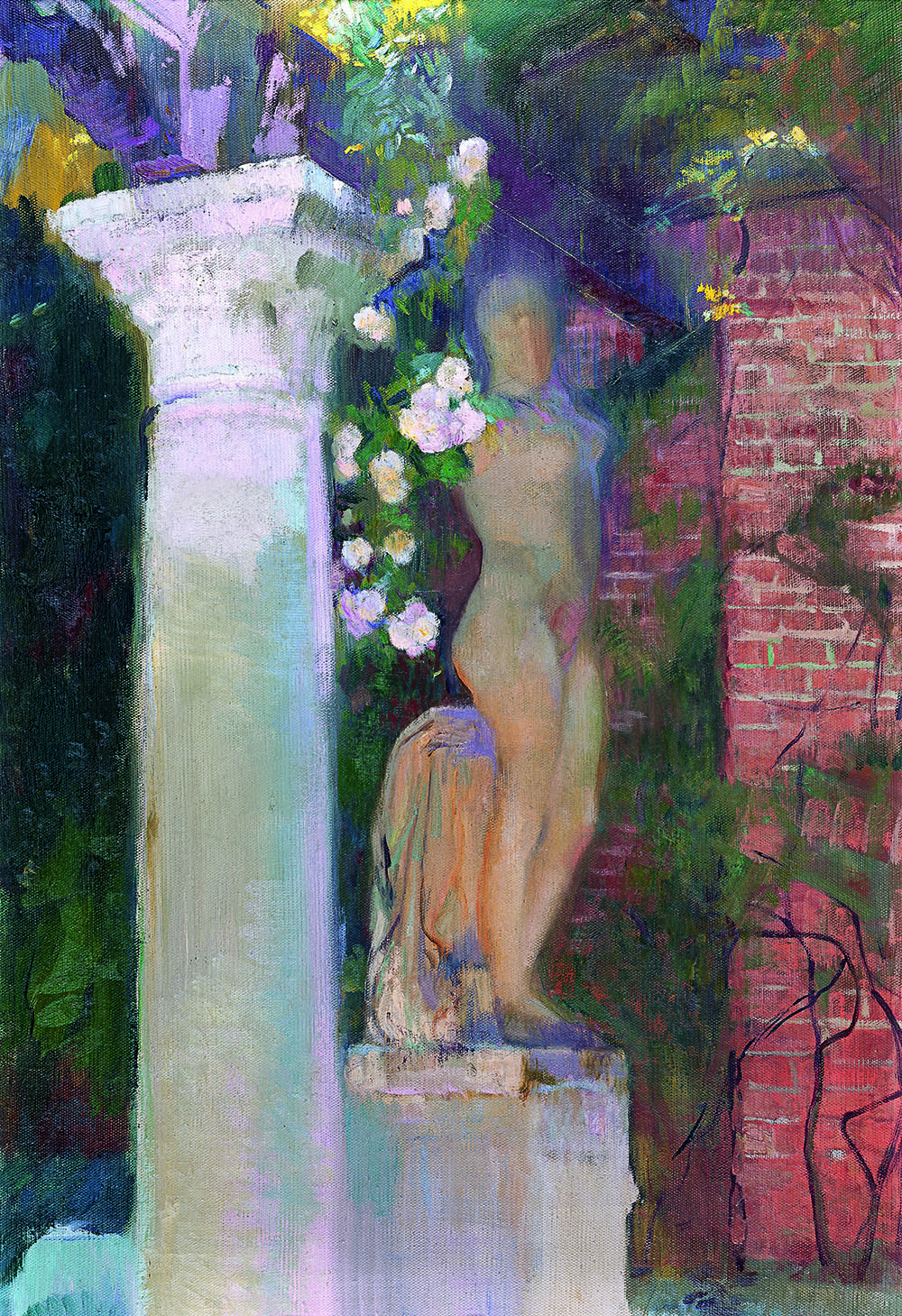
1905, Port of Jávea
Joaquín Sorolla y Bastida (Spanish, 1863–1923)
Oil on canvas on board, 5 1/8 x 5 7/8 in. (13 x 15 cm). Private Collection.
Photo: Personal Archive, Blanca Pons-Sorolla, Madrid

1906, Shadow of the Alcátrana Bridge, Toledo
Joaquín Sorolla y Bastida (Spanish, 1863–1923)
Oil on canvas, 26 x 36 7/8 in. (66 x 93.5 cm). Cristina H. Noble.
Photo: Personal Archive, Blanca Pons-Sorolla, Madrid.

SOROLLA: THE ARTIST, THE MAN
 Joaquín Sorolla was born in Valencia on February 27, 1863, his parents died in 1885 when Sorolla was 18″. He was taken in with his sister by his aunt Isabel. Isabel’s husband was a locksmith and tried to teach Joaquin the trade, but his obsession was painting and he enrolled in the School of Craftsmen in Valencia to learn drawing.
Joaquín Sorolla was born in Valencia on February 27, 1863, his parents died in 1885 when Sorolla was 18″. He was taken in with his sister by his aunt Isabel. Isabel’s husband was a locksmith and tried to teach Joaquin the trade, but his obsession was painting and he enrolled in the School of Craftsmen in Valencia to learn drawing.
In 1885, when Sorolla was 18 years old and his genius was beginning to manifest itself, he decided to go to Paris, where he came into contact with the impressionists and other avant-garde artists.
In the decade of the 90’s, exhibiting in Paris, he acquired notoriety throughout Europe, and a great international recognition.
In 1909, at the behest of the great patron of the arts Archer Milton Huntington, he opened his exhibition at the Hispanic Society in New York, which allowed him to launch a successful career in the United States.
In the 1910s his health began to fail, he suffered from frequent dizziness and in 1920, he suffered a hemiplegia that drastically diminished his faculties and prevented him from continuing to paint.
A detailed history of his extraordinary life and successes is described in the exhibition catalog.
Sorolla by himself
As Sorolla said in 1912 in an interview for the New York–based magazine Art and Progress: “Light is the life of everything it touches. . . . ‘La lumière c’est la vie,’ therefore, the more light there is in the paintings, the more life, and the more truth, and the more beauty.”
On another occasion the painter also explained how the simple continuous movement of the sun changes the appearance of things: “You have to paint quickly, because of how much is lost, fleeting, and never to be found again!”
Sorolla became what he wanted to be: “a painter and nothing more than a painter,” in his own words. He lived for his painting and his family. He dedicated himself completely to every work he painted with the passion of a lover.
Sorolla by his wife
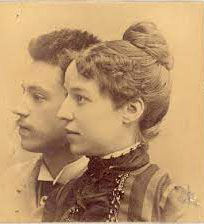 In one of her letters, Sorolla’s wife, Clotilde, complained about her eternal “rival,” painting, while simultaneously wishing that her husband would never lose his devotion to the activity that meant “everything in this world” to him. The couple shared an intense love throughout his life, as their 2000 letters to each other attest.
In one of her letters, Sorolla’s wife, Clotilde, complained about her eternal “rival,” painting, while simultaneously wishing that her husband would never lose his devotion to the activity that meant “everything in this world” to him. The couple shared an intense love throughout his life, as their 2000 letters to each other attest.
Sorolla by the critics
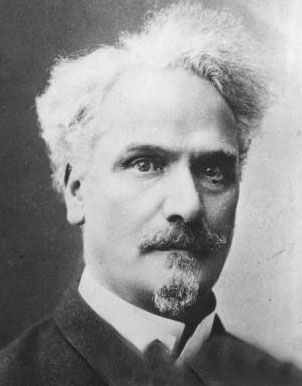 Henri Rochefort In his 1906 article “Un astre qui se lève,” Henri Rochefort, a journalist known for his independence of judgment, commented on his visit to Sorolla’s exhibition at the Galerie Georges Petit in Paris: “A magnificent painter was born. Unfortunately, it was not in France… I do not know any other brush that contains so much sun… The painting of this artist has nothing to do with impressionism, but it is incredibly impressive.“
Henri Rochefort In his 1906 article “Un astre qui se lève,” Henri Rochefort, a journalist known for his independence of judgment, commented on his visit to Sorolla’s exhibition at the Galerie Georges Petit in Paris: “A magnificent painter was born. Unfortunately, it was not in France… I do not know any other brush that contains so much sun… The painting of this artist has nothing to do with impressionism, but it is incredibly impressive.“
 Ramiro de Maeztu. An article by the Spanish critic Ramiro de Maeztu from 1908, following Sorolla’s only exhibition in London, is fulsome in its praise: “This man must have the greed to want to paint everything; the passion to surprise all aspects of nature, even the most furtive and unstable…”
Ramiro de Maeztu. An article by the Spanish critic Ramiro de Maeztu from 1908, following Sorolla’s only exhibition in London, is fulsome in its praise: “This man must have the greed to want to paint everything; the passion to surprise all aspects of nature, even the most furtive and unstable…”
“These fugitive aspects could be reproduced only by Sorolla’s quick and sure brush. This is his art; no one can surpass him at that. Noone has a more prepared synthesis of the first vision of things on his palette.”
“This man has the strange power to paint in a few hours everything that is placed in front of him and to reproduce for us the illusion of life…”
Sorolla by his admirers
 Archer M. Huntington. At the close of the 1909 New York exhibition, Archer M. Huntington, was equally enchanted, writing to his mother: “Everywhere the air was full of miracle. People quoted figures of attendance. There was eternal talk of ‘sunlight.’ Nothing like it had ever happened in New York. Ohs and Ahs stained the tile floors. Automobiles blocked the street.”
Archer M. Huntington. At the close of the 1909 New York exhibition, Archer M. Huntington, was equally enchanted, writing to his mother: “Everywhere the air was full of miracle. People quoted figures of attendance. There was eternal talk of ‘sunlight.’ Nothing like it had ever happened in New York. Ohs and Ahs stained the tile floors. Automobiles blocked the street.”
Interviewing Blanca Pons-Sorolla
Renowned Sorolla scholar, curator of the exhibition and the artist’s great-granddaughter
Photos by Paloma “Hiranda”

PATRONS: You have been interviewed by the most important press in the world. What is the one question you would have liked to have been asked about Sorolla that nobody has asked you?
BLANCA: I can’t think of it, Sorolla has been asked about everything.
PATRONS: What are the essential masterpieces that should feature in an anthological exhibition about Sorolla and would best represent him?
BLANCA: Basically they have as an example the exhibition at the London National Gallery in 2019, which brought together all the great prizes, although some works were missing for me fundamental as “Evening Sun”, “Summer” or “Clotilde strolling through the gardens of La Granja”, which could not be and that at the moment it will be very difficult to appear in exhibitions.
In any case, Sorolla has such a wide and good production that it is not difficult to put together an anthology of great quality depending on what is possible at any given moment. Of course, a strong sponsor will be needed.
What will be unrepeatable is a retrospective like the one at the Prado Museum in 2009. There were a series of circumstances then that will never happen again. At least that’s how I think.
PATRONS: Museums worldwide are undergoing a major transformation How do you think the Sorolla Museum in Madrid should be updated museistically?
BLANCA: At the moment the expansion is pending completion, something that was very necessary, which will mean a reorganization of the spaces. When it is finished and reorganized we will be able to give our opinion.
In any case, we must not forget its character of House-Museum that must be preserved, and its condition of historical building and garden that limits certain actions. The approaches that are made will have to be based on not losing the character that has been maintained so far.
PATRONS: What do you think about the immersive exhibitions that are being held worldwide with the work of great masters of painting?
BLANCA: There is a danger of forgetting how important it is to see and be moved by the original work. For me, as long as it is done very well and with the highest quality, it can be a good complement, but it will never replace the wonder of an exhibition with original works.
PATRONS: Exhibitions with figurative works become “blockbusters” if their contents are excellent and they are well communicated What is the reason for not holding more exhibitions of great masters?
BLANCA: I guess it’s fashion and cultural politics…
PATRONS: Are there projects to promote exhibitions of Sorolla worldwide?
BLANCA: As far as I know at this time only the one at the Meadows Museum in Dallas
PATRONS: What facilities for your work does being Sorolla’s great-granddaughter give you?
BLANCA: I am one of the many great-granddaughters of Sorolla, and the only thing I feel is a greater responsibility to do well, to live up to my great-grandfather deserves.
PATRONS: At what stage of completion is the Catalogue Raisonné of Sorolla’s work that you are preparing, is there a date planned?
BLANCA: The first two volumes containing the 2,100 works painted from its beginnings up to and including 1903 are ready. They are only awaiting the work of editing and publication. What is needed is to get a sponsor or sponsors for it. The idea has always been to publish them at the same time.
Of the next two, which cover the works painted between 1904 and 1920, the year he stopped painting, I have 1,100 files of the 2,140 works ready. Of these, 1,040 are from the third volume and 60 from the fourth volume.
I still have 1,100 cards to do, but the “Sorolla Year” has drastically stopped my work with the catalog raisonné, something I hope to resume next year. The idea, as in the previous case, is to publish them at the same time.
STATEMENTS
 Amanda W. Dotseth
Amanda W. Dotseth
the Linda P. and William A. Custard Director of the Meadows Museum
“This exhibition offers a unique look at Sorolla’s work from private American collections. Thanks to a group of exquisite paintings rarely seen in public, audiences are invited to appreciate the artist’s captivating talent as a painter of light.”
“Spanish Light: Sorolla in American Collections, reveals Sorolla’s continued popularity in this country, which can be traced back to the American collectors who supported him during his lifetime. By participating in the Sorolla Centennial, the Meadows joins other institutions in Spain and elsewhere to introduce or reengage audiences with the work of this important artist.”
 Cristina Domenech
Cristina Domenech
PhD in Art History
“The general public, collectors, and the American press have appreciated Sorolla’s paintings to the point that the United States is probably the country with the greatest number of works by the artist—in both private and public collections—after his native country”. “As Mark Roglán aptly noted in 2014: Nowhere did Sorolla receive as much support as in the United States. The success he enjoyed in this country is unmatched by any other Spanish artist until the arrival of Pablo Ruiz Picasso (1881–1973).”
“We trust that this exhibition will highlight the quality of Sorolla’s work in private collections as well as the affinity and enthusiasm with which Americans have received and appreciated his paintings.”
Exhibition view. Photos by Paloma “Hiranda”
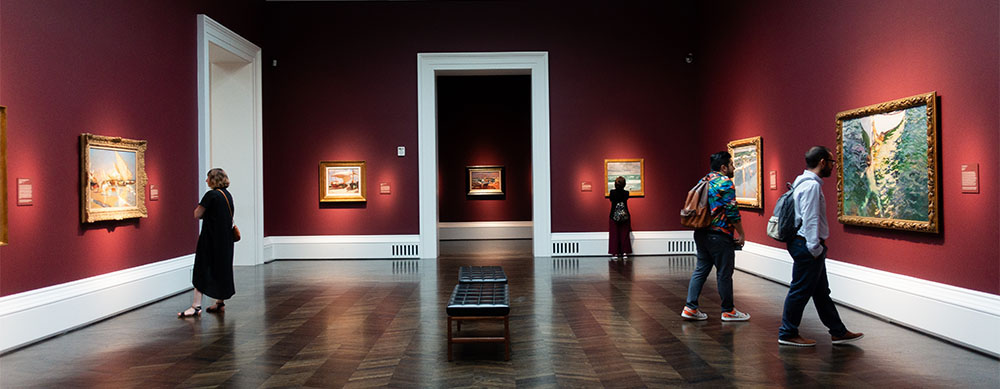
THE EXHIBITION CATALOG
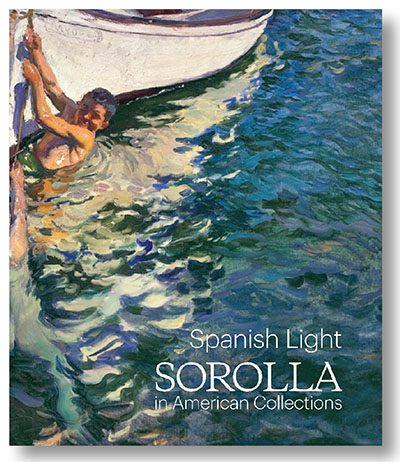
Spanish Light:
Sorolla in American Collections
Editor: Blanca Pons-Sorolla
Contributor: Cristina Domenech
Softcover, 88 pages
$30
To purchase, contact the Meadows Museum Shop at [email protected] or 00 1 214 768 1695.
Spanish Light: Sorolla in American Collections is an opportunity to gather and present images of these privately held works even after the close of its eponymous exhibition. It features an introduction and chronology by editor and exhibition curator Blanca Pons-Sorolla, a preeminent scholar of Sorolla’s work and the artist’s great-granddaughter. Art historian Cristina Domenech has also contributed an essay that offers perspectives on the artist’s popularity among American private collectors past and present, and explores the collecting history of the featured works. The research for this publication is based in part on that conducted for museum’s groundbreaking 2013–14 exhibition Sorolla and America, which was also curated by Pons-Sorolla, and in which Cristina Domenech also contributed an essay.
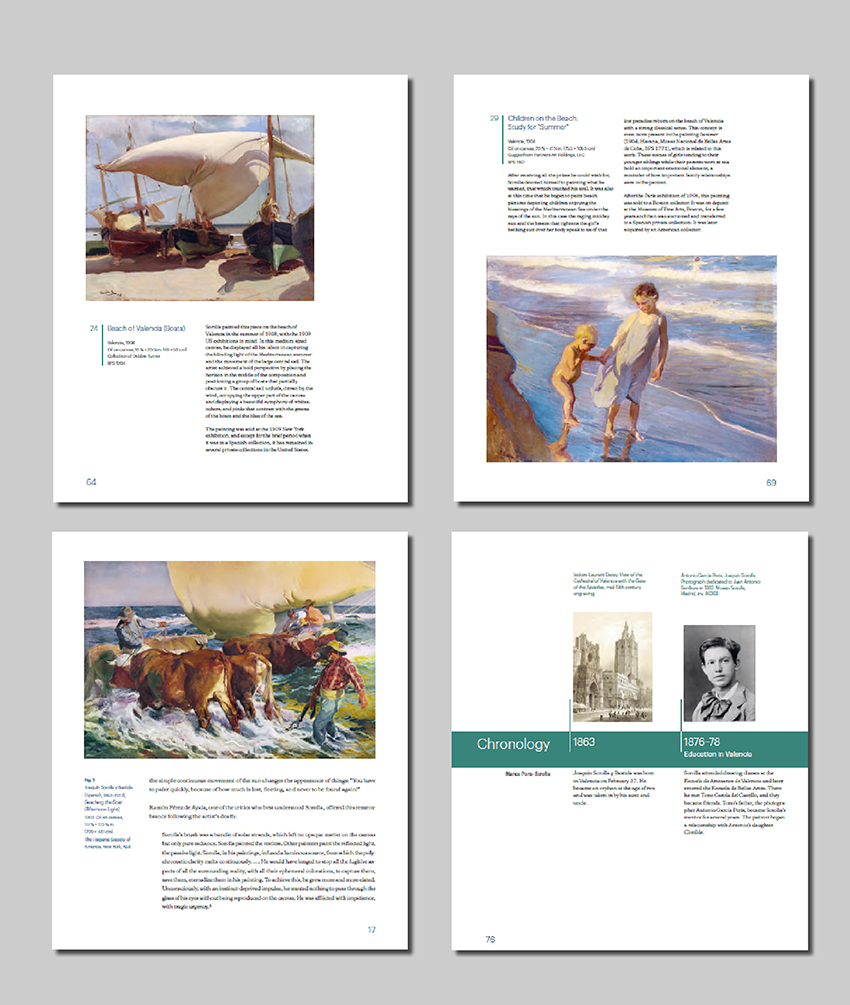
This exhibition has been organized by the Meadows Museum.
A generous gift from The Meadows Foundation has made this exhibition possible
Promotional support is provided by the Dallas Tourism Public Improvement District
 MEADOWS MUSEUM
MEADOWS MUSEUM
5900 Bishop Blvd., Dallas, TX 75205 Tel: 214-768-2516
https://meadowsmuseumdallas.org/